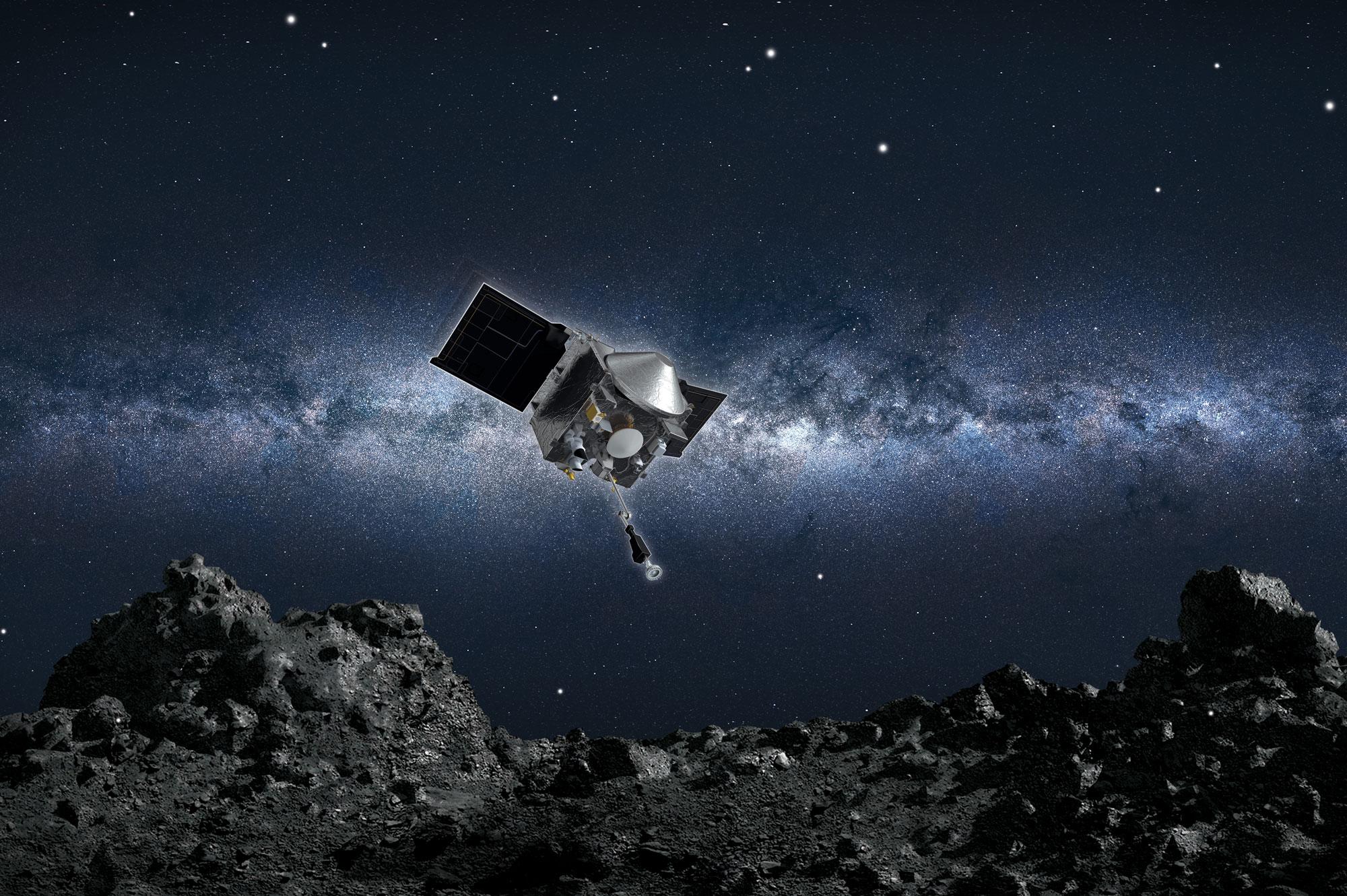
If all goes well this Sunday morning, a two-ounce clue to the mystery of the universe will land in the Utah desert.
That’s when NASA’s OSIRIS-REx spacecraft is scheduled to swing by Earth and drop a tire-sized capsule to the ground. Carefully packed inside are a couple of ounces of space rocks and dust collected from the asteroid Bennu, 200 million miles away.
“(Scientists) believe that Bennu is from the formation of the solar system, and that this will teach us more about the building blocks or the origins of the solar system,” said Sandy Freund, program manager for OSIRIS-REx at Littleton’s Lockheed Martin, the prime contractor for the mission.
“But anytime you bring anything back from space, you'll learn something just about what's out there and maybe what has collided with it in the past.”
OSIRIS launched in September 2016 and arrived at Bennu two years later. After almost two more years to study and map the asteroid, scientists picked a spot and deployed a robot arm to retrieve the sample.
The maneuver, Freund said, was called “touch-and-go” and, considering it was the heart of a seven-year mission, it happened really fast. “It’s just a matter of seconds that we’re actually in contact with the asteroid,” she said.
After Sunday’s flyby, OSIRIS will head back into space to explore another asteroid, and the little sample from Bennu will head to NASA’s Johnson Space Center for study.
Read the interview
This interview has been edited for length and clarity.
Ryan Warner: This sample is expected to land in the Utah desert in a little capsule. When scientists get it open, what will they see?
Sandy Freund: We're slated to land in the Utah Test and Training Range. When they open up the capsule, we'll see our collector inside that should have all of our samples of asteroid Bennu in it. It'll actually take them a number of days to fully disassemble that to see exactly how much sample is inside of there.
Why does it take several days to disassemble?
They want to be very careful that they have every little piece of dust or rock, anything from the asteroid. They want to make sure they collect and categorize it correctly and get it put into their science catalog.
I mean, if you have invested as much time and energy and money in bringing back a sample, you want every square millimeter of that thing.
Right. Absolutely.
Do you believe it's like a sandy consistency or more rocky, pebbly?
The images we have make it look like a very rocky surface and there are definitely large boulders on the surface of Bennu. However, when we made contact, it looks like a lot of those rocks just broke apart rather easily, so we expect inside of the collector is a lot of fine-grained dust but also a lot of rocks.
So crumbly. What do scientists hope to learn from it?
They believe that Bennu is from the formation of the solar system, and that this will teach us more about the building blocks or the origins of the solar system. So that is their main goal. But anytime you bring anything back from space, you'll learn something just about what's out there and maybe what has collided with it in the past.
So can we say this is some of the oldest material in the universe?
That's what they believe, but again, once the sample's on the ground is when they'll be able to actually confirm their hypothesis.
Is there any concern of unleashing some space virus? Are there any concerns about contamination?
No, not at all. This sample is not labeled as hazardous whatsoever. It is going to be opened in a clean room and taken care of just as the previous samples that have been returned to (NASA’s) Johnson Space Center (in Texas). But no concerns of harboring any virus.
I understand there's a chance – a very, very slim chance – that the asteroid Bennu, from which this sample is coming, could one day crash into the Earth. Does that play a role in wanting to learn more about Bennu?
It does.The primary goal is to understand what Bennu is made up of, but there is great interest amongst the science community, as well as NASA, to understand how we can deflect asteroids that come near Earth. And so we have, as part of the science on this mission, learned more about Bennu’s orbit, how it changes. But there is a very small chance in the late 2100 timeframe that Bennu will come close enough to Earth for potential impact.
How big is Bennu?
Bennu is 500 meters in diameter.
Is it possible that the sample is material we've never seen before, or is it just going to be similar to what we have on Earth?
It'll be more pristine from an asteroid. There's lots of things that reenter (Earth’s atmosphere) – meteorites all the time that come back in. But this sample will be pristine because it's going to be protected from the atmosphere when it comes in. So there's always a chance they find something they weren't expecting. We have a lot of science instruments on board, so they have a good idea of what Bennu is like. But the samples (being analyzed by) the labs and the technology we have here on Earth will be a great benefit.
This is fascinating. In other words, this is bringing it back in a very controlled environment, as opposed to burning up in the atmosphere and kind of making it here and having gone through this rather crazy transformation. I mean, that's normally how this stuff comes back, right?
Right.
This is not the first time a sample has been collected from an asteroid. The Japanese did it several years ago. Once it got back to Earth, it was a little chaotic getting it to NASA for analysis. They packed the samples in suitcases, negotiated with TSA so they didn't get X-rayed and put them in seats on a commercial airplane. Have Lockheed and NASA got a better plan?
So the Hayabusa mission is our sister mission out of JAXA (Japan Aerospace Exploration Agency) and we have some of their sample and we will share some of our sample with them. However, the means of transporting the sample is not something that is widely shared.
Well, that makes sense. You don't want anything thwarted or interrupted. So the mission here is rather fundamental science exploring the origins of the universe. But I know some private companies – we spoke to one in Colorado not long ago – are looking at asteroids as a resource. They want to mine minerals and maybe water. Do you think that plays into this as well?
A little bit. I think the asteroid mining portion of wanting to explore is vastly different than the scientific reasons to explore. But the more we learn about asteroids, the more I think it helps both.
Everyone might learn a little something here, depending on their interests. Okay, more about how to take a sample from an asteroid. How fast is Bennu traveling, and how did OSIRIS-REx catch up with it?
So I don't know if I can give you an exact speed of Bennu but I can at least talk about how we collected the sample…We approached Bennu in late 2018, and we spent some time flying back and forth around the asteroid before we got into orbit and then we went in and out of orbit several times.
Because it's large enough to have its own orbit?
Right. Yep. And a small amount of gravitational field around it. So we actually hold two Guinness Book of World records on this mission for a smallest body ever orbited and smallest orbit. So it was quite the feat with our navigation team and engineering team to fly that trajectory.
And then how fine can you get with the movements of OSIRIS-REx?
So we had to line up exactly with Bennu's rotation for our touch-and-go, or TAG, which was sample collection. We wanted to make sure that we touched down in a particular crater called the Nightingale crater. That was our sample collection site deemed to be most interesting by science and achievable from an engineering standpoint to get to the surface and back away in a safe manner.
And how fast is that process? How quick is the touch-and-go?
It's just a matter of seconds that we're actually in contact with the asteroid. The entire event is on the order of hours, because you need to leave orbit, descend at the surface, touch the surface to get the sample and then back away. So the entire event was on the order of four or so hours, but the actual contact with the surface was just a handful of seconds.
Is all of that pre-programmed, or is there someone with a joystick?
It's all pre-programmed because Bennu is tens of minutes away when we did our sample collection, so you can't do anything in real-time. So we send all the parameters and sequences to the spacecraft ahead of time, and then, we wait and watch from ground.
Tens of minutes away, meaning the delay on communication on any signal is significant.
Right.
That's not a real-time affair. You called the crater Nightingale. Was that after Florence, or are we talking about the bird?
Bird. So all features on Bennu are named after Egyptian birds.
And what does Bennu mean?
There is an Egyptian tie to that. Bennu was named by a third-grader in North Carolina prior to launch. So the asteroid had an RQ number name, and there was a contest to name the asteroid for this mission.
Okay, we are going to Google this together and discover it together. Bennu – an ancient Egyptian deity linked with the sun associated with creation and rebirth. And apparently, this student thought the touch-and-go device was shaped similar to a heron.
So talk to me about your state of mind after the touch and go. When you knew it was successful, how did that feel?
That was a lot of relief and excitement. There's a lot of preparation that goes into doing anything in deep space flight and especially doing something never done before and so the moment that we knew that we had captured enough sample to be considered successful was really the point in which I think the team celebrated.
And maybe breathed again?
Right. Then we had to stow the sample, which we knew was going to be an intricate process.
Oh, how so?
The sample collector is on the end of about an 11-foot arm and it's similar to our arm, where you have an elbow-wrist kind of joint that you have to move in a particular fashion in order to get that sampler head tucked into the return capsule just right. So that whole process took us just over a day to get everything lined up just right and snapped into the return capsule and have that closed.
And secure. Now, OSIRIS-REx, since this touch and go, has simply been coming back towards Earth. It's a long journey.
So our sample collection was October 20th of 2020. We flew back by the Nightingale Crater in April of 2021 just to have pre- and post-images of where we had done the collection. And then, we left Bennu in May of 2021. So it's been almost a year-and-a-half of cruising home.
It's remarkable you remember those dates. It's almost like a friend's birthday.
Yeah, a little bit. A lot of those things stick with you, launch dates, Earth return dates.
What happens to OSIRIS-REx after it kind of deposits this near us?
We'll swing by Earth and drop off the return capsule on Sept. 24 and then the spacecraft will actually head out on an extended mission to go to asteroid Apophis, and will arrive there in 2029.
Okay. And is that an asteroid that is farther from us than Bennu or closer?
It's closer. Apophis will make its closest approach to Earth in April of 2029, just before we get there.
Now this capsule will have to go through the atmosphere. So I imagine that it's quite heat-protected.
Yes, it definitely has a heat shield on board. The capsule itself is very similar to our Stardust mission that brought back samples of Comet Wild 2 in 2006.
What size is it? What should I be picturing?
It's about 80 centimeters in diameter. Weighs about 50 kilograms, so it takes about two people to pick up....Kind of like the size of a large tire.
Will your eyes get to see, for themselves, what it brings back, or will this all be screens and photos that are sent to you?
So here in Denver we'll be sending the commands to release the capsule, and then we'll have our recovery team in Utah. The recovery team will pick up the return capsule, disassemble it a little bit in order to get a nitrogen purge on the sample, and then they'll package everything up and fly it down to Houston.
A nitrogen purge. What's that?
That's in order to keep the sample pristine. We don't want it to be exposed to anything else here on Earth any more than it has to so they'll put a nitrogen purge on it, get it all packaged up and sent down to the Johnson Space Center the following day. Some of our team members will actually travel down to Houston and will be able to, at that point, reunite with our recovery team. We will have lots of video feeds and things that the science team will make available to us.
But you, Sandy ... You will be minding the fort here?
I will be here in Denver, or in Littleton, where we fly our spacecraft from, from the Lockheed Martin facility there, and then I will travel to Houston.
Sandy Freund is Spacecraft Mission operations manager for Lockheed Martin in Littleton. If all goes as planned, OSIRIS-REx will return a sample of the asteroid Bennu to Earth on Sunday.









